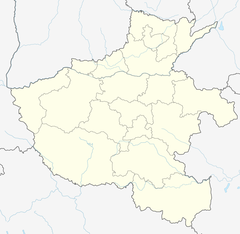Iron Pagoda
| Iron Pagoda | |
|---|---|
 The Iron Pagoda of Kaifeng, China, built in 1049 | |
| Religion | |
| Affiliation | Han Chinese Buddhism |
| Location | |
| Country | Kaifeng City, Henan province |
Location in Henan | |
| Geographic coordinates | 34°49′00″N 114°21′54″E / 34.81667°N 114.36500°E |
| Architecture | |
| Completed | 17 June 1049 |
The Iron Pagoda (Chinese: 鐵塔) of Youguo Temple (佑國寺), Kaifeng City, Henan province, is a Chinese pagoda built in 1049. The pagoda is so-named not because it is made of iron, but because its color resembles that of iron. It is a brick pagoda tower built on the location of a previous wooden one that had been burnt down by lightning fire in 1044. Along with the Liuhe, Lingxiao, Liaodi, Pizhi, and Beisi pagodas, it is seen as a masterpiece of Song dynasty architecture.
Architecture[edit]
This octagonal-base structure stands at a current height of 56.88 meters (186.56 feet), with a total of 13 stories.[1] It is a solid-core brick tower with an inner spiral stone staircase and outside openings to allow light and air flow.[2] The architectural style features densely positioned, articulated dougong in the eaves (miyan) and multiple stories (louge).[2] The exterior features more than fifty different varieties of glazed brick and 1,600 intricate and richly detailed carvings, including those of standing and sitting Buddha, standing monks, singers and flying dancers, flowers, lions, dragons and other legendary beasts as well as many fine engravings. Under the eaves are 104 bells that ring in the wind. The foundation rests in the silt of the Yellow River.[3] Inside the Iron Pagoda are frescos of the classical Chinese tales, such as The Journey to the West.[4]
History[edit]
In the Northern Song (960–1127) dynasty's capital city of Kaifeng, the famous architect Yu Hao built a magnificent wooden pagoda as part of Youguo Temple (between 965 and 995 CE.) that was considered by many of his contemporaries to be a marvel of art.[5] Unfortunately, the widely admired structure burned down in 1044 after a lightning strike.[5] Under the order of Emperor Renzong (1022–1063), a new pagoda was built in its place by 1049. The new tower was built of nonflammable brick and stone and was dubbed the 'Iron Pagoda' due its iron-grey color when viewed from afar (its bricks are in fact glazed red, brown, blue, and green). In 1847 the Yellow River overflowed its banks and the Youguo Temple collapsed, but the Iron Pagoda survived. Historically, the pagoda has experienced 38 earthquakes, six floods and many other disasters, but it remains intact after almost 1,000 years.[3][6]
In 1994, the Iron Pagoda was featured on a two-yuan Chinese postage stamp.[7]
Gallery[edit]
-
detail
-
detail
-
glazed tiles of Iron Pagoda
See also[edit]
References[edit]
- ^ Chinadaily.com.cn (2003). Iron Pagoda. Ministry of Culture. Retrieved on 2007-03-29. Archived August 6, 2007, at the Wayback Machine
- ^ a b Daiheng, Gao (2002). Chinese Architecture – The Lia, Song, Xi Xia, and Jin Dynasties (English ed.). Yale University Press. pp. 166, 183. ISBN 978-0-300-09559-3.
- ^ a b "Iron Pagoda". China Culture. Archived from the original on 2007-08-06. Retrieved 2007-09-03.
- ^ Harper, Damian (2005). China. Lonely Planet. p. 400. ISBN 978-1-74059-687-9. Retrieved 2007-09-03.
youguo temple.
- ^ a b Needham, Joseph; Gwei-Djen, Lu; Wang, Ling (1971). Science and Civilisation in China, volume 4, part 3, Civil Engineering and Nautics. Cambridge: Cambridge University Press. pp. 81–82. ISBN 978-0-521-07060-7.
- ^ "Youguo Temple Iron Pagoda in Kaifeng of Henan Province". china.org. Retrieved 2007-09-03.
- ^ "1994-21: Pagodas of Ancient China – 1994". chinesestamps.org. Archived from the original on 2007-09-21. Retrieved 2007-09-04.
External links[edit]
- Buddhist temples in Kaifeng
- Pagodas in China
- Buildings and structures in Kaifeng
- Religion in Kaifeng
- Song dynasty architecture
- Major National Historical and Cultural Sites in Henan
- 11th-century Buddhist temples
- 11th-century establishments in China
- Religious buildings and structures completed in 1049
- Tourist attractions in Henan







